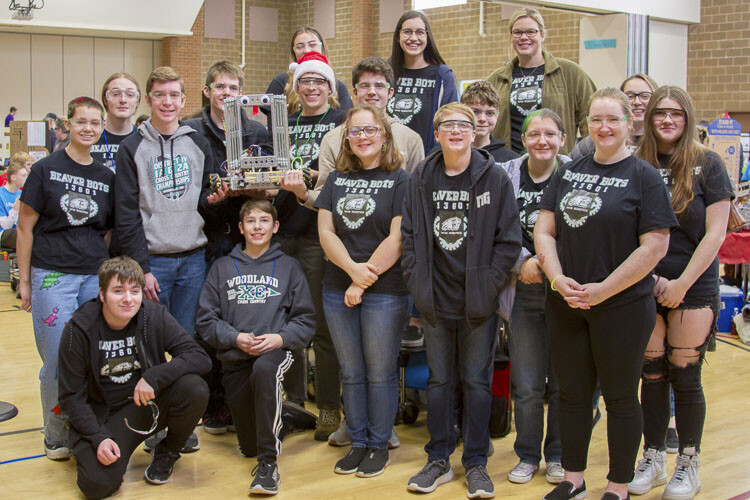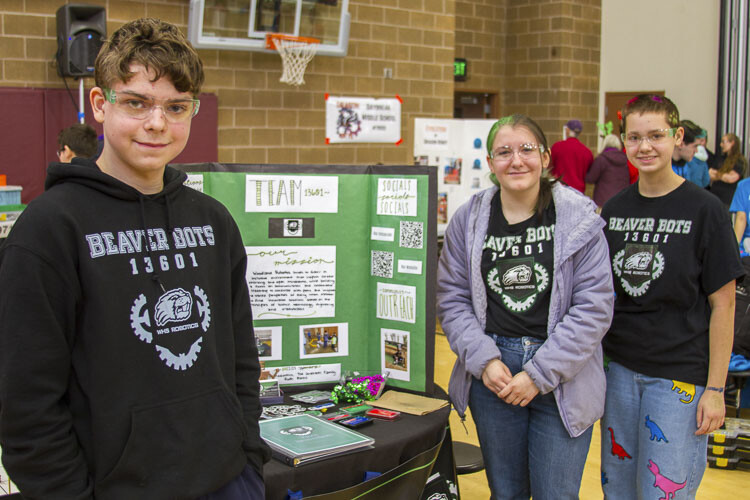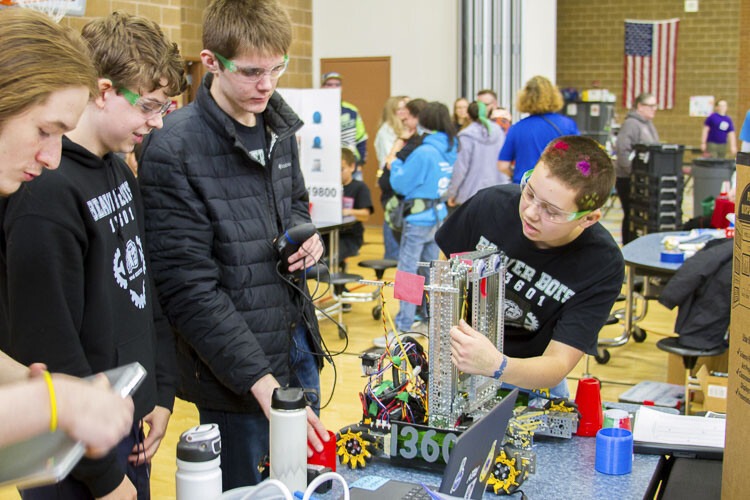
The Beaver Bots are one of 140 teams at high schools across Washington state taking part in the For Inspiration & Recognition of Science & Technology robotics competitions
Woodland High School’s robotics team, the Beaver Bots, attracts a diverse range of students from every grade level to compete against other schools’ robots in events involving challenging tasks and logic-based problems inspired by real-world scenarios.
The Beaver Bots are one of 140 teams at high schools across Washington State taking part in the For Inspiration & Recognition of Science & Technology (FIRST) robotics competitions. FIRST kicks off each year-long competition with a different theme including detailed tasks and a list of specifications what parts teams can use to build their robots. This year’s theme, Power Play, revolves around the concept of electricity and circuits. In a timed match, teams’ robots must travel autonomously from a starting point to pick up items and then deliver them to the other side of the field to complete a “circuit” with the most effective robot receiving more points.

Jennifer Benedict and Stephanie Marshall, math and science teachers at the high school, respectively, serve as the team’s advisers, however the students almost exclusively manage the team. “We make sure the team is nearly entirely student-led,” said Marshall. “We serve as the advisers, but we want the students to learn and grow by handling every aspect of the team.”
This year, the robotics team gained 12 new members, nearly doubling the size of the team. “We are so excited to have so many new members,” said Marshall. “We had to implement a leadership hierarchy with a board of five students making the most of the decisions so we could ensure everything gets done and nothing is missed.”
The team features three different roles: builders, programmers, and project managers. The team starts each season by brainstorming ideas for the robot and drafting initial designs using the specifications provided by the FIRST League’s organizers. Communication and teamwork between each of the three groups leads to the success of the team as a whole. The close-knit teamwork was what drew Angelina Smith, a senior and one of the team’s leads, to robotics, “I like working in groups and my teammates are all very cool,” she said. “I really like the creativity, particularly brainstorming sessions where we’re finding creative solutions to problems.”
Following the initial planning stages, the builders create the robot, making modifications as needed along the way. The programmers use JavaScript, a programming language, to program the different elements of the robot which may include a variety of engines and moving pieces such as arms, claws, or legs. Programmers must also create artificial intelligence for the robot to allow it to move autonomously without human interaction for part of the competition.
The project managers create and maintain the Engineering Notebook which includes compiling the building plans, tracking any design changes, and maintaining the team’s budget along with ordering parts and documenting receipts. The Engineering Notebook is judged during the competition with judges scrutinizing the notebook for the current project as well as an included plan for how to keep the club going in the future.

Many members joined after their friends recruited them. “I joined last year after a few of my friends already on the team convinced me to come out,” said Alyssa VanCleef, a junior. “My role is to take over as a lead next year so I’m doing a bit of everything; I really enjoy the interaction because we have such a close-knit team.”
New members join for a variety of reasons. “I love building and engineering; it fascinates me so much,” explained Morrigan Chapman, a sophomore who joined this year. “I have always built projects at home – it’s what I absolutely love – and I’ll likely go into engineering or mathematics after I graduate.” For Grayson Tinker, a freshman who also joined this year, his experience in a robotics class in fifth grade motivated him to sign up. “I really like watching how all the pieces go together, not just the robot itself, but also the entire team,” he said. “I’m a junior programmer this year so I’m focusing on learning the language we use and practicing with our senior programmers.”
For community members interested in learning how to support the Beaver Bots, you can contact the team at their email address: whsroboticsteam@woodlandschools.org. The Robotics Club and STEM classes offered at Woodland High School are just a few of the many programs and activities funded by local levy dollars and the Woodland community’s ongoing support of their schools.
Learn more about how Woodland Public Schools educates students and serves the community by visiting the dedicated news webpage at www.woodlandschools.org/news/wsd
Information provided by Woodland School District.
Also read:
- Verizon-Cellular Plus giving away free backpacksVerizon-Cellular Plus in Clark County will be giving away free backpacks filled with school supplies on Saturday (July 27) from 10 a.m. to noon.
- Washougal High School earns 2024 Jostens Gold Tier School of Distinction AwardLast week, Washougal High School (WHS) student leaders were recognized with the 2024 Jostens Gold Tier School of Distinction Award for their work to improve school climate and culture.
- Journey Theater getting ready to present ‘The Music Man’Local theater group will have five performances at The Garver Theater in Camas, with opening night set for Aug. 2 Harold Hill had a plan, a plan to con a bunch of folks in the Midwest. But will love get in the way of that plan? By turns wicked, funny, warm, romantic and touching, The …
- Annual Write From the Start School Supply Drive scheduledFor the 9th Year in a Row, Dick Hannah Dealerships Partner with the Foundation for Vancouver Public Schools on their annual Write From the Start School Supply Drive.
- SW Washington’s Lemonade Day Youth Entrepreneur of the Year named by Greater Vancouver ChamberTatum Talbert, a 10-year-old from Camas, who owns Tatum and Her Gnomies, was named the 2024 Southwest Washington Lemonade Day Youth Entrepreneur of the Year by the Greater Vancouver Chamber.









